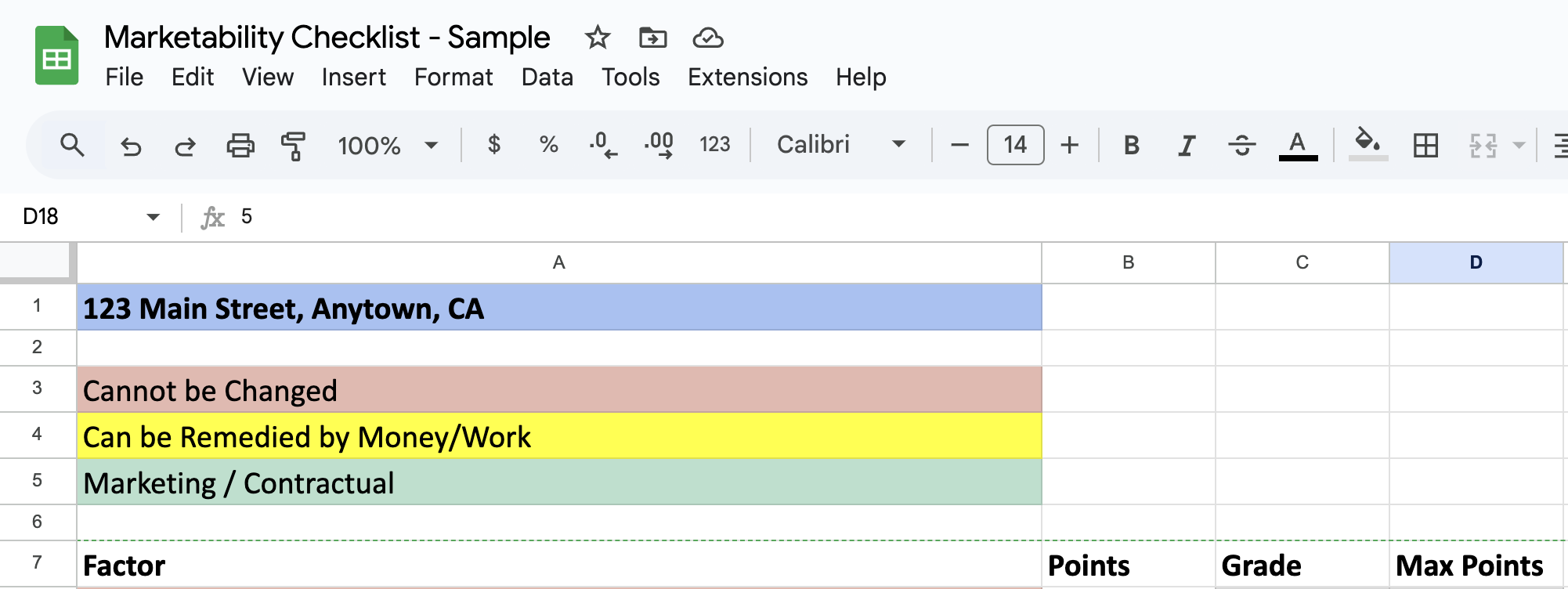In the topsy-turvy world of Bay Area real estate, accurately pricing a home is both an art and a science. Sellers often grapple with determining the optimal price that not only reflects their property’s true value but also appeals to potential buyers. One common tool that most REALTOR®s use is a Comparative Market Analysis (CMA), which strives to estimate a home’s likely sale price. However, the CMA fails to take into account numerous factors that will affect demand for the home on the open market, giving sellers an incomplete picture of their home’s competitive position in the market.
To bridge this gap, I have developed a comprehensive Marketability Checklist designed to assess a property’s appeal and guide sellers toward an effective pricing strategy. This article delves into the components of this checklist, elucidating why certain factors are weighted more heavily than others, and how the resulting score can inform a strategic pricing approach for an optimal sale.
Understanding the Marketability Checklist
The Marketability Checklist is a diagnostic tool (a shareable google spreadsheet) that evaluates various aspects of a property, the marketing strategy, and a variety of macroeconomic conditions to quantify the amount of value the market will ascribe to the property. By assigning points to specific criteria, sellers gain a more objective measure of their home’s strengths, weaknesses, and challenges it may face in the marketplace. This systematic assessment ensures that all critical factors influencing buyer decisions are considered, leading to a well-informed pricing strategy.

Sections of the Checklist
My marketability checklist is broken down into three sections:
- Cannot be Changed (Red Group)
- Can be Changed by Money / Work (Yellow Group)
- Marketing / Contractual (Green Group)
Immutable Conditions (Red)
There are certain things that can never be changed (by you) about your property. For example, you cannot change your property’s location. There are many factors you need to consider about your location, such as fire and floor insurance cost, WalkScore, economic obsolescence, school quality, vehicle congestion, and many more. These factors will have a significant impact on how eagerly your property will be received by the market.
Improvable Conditions (Yellow)
One of the great things about real estate as an investment is that there are many things that a homeowner can do to improve their property’s value. The marketability checklist identifies numerous factors that are under the seller’s control which will impact the property’s acceptance by the market: cleanliness, curb appeal, overall condition, smell, functional obsolescence, and many others. Some of these items are obviously pretty easy to improve (e.g. cleanliness), while others are much more difficult (functional obsolescence). Regardless of a seller’s desire or capacity for addressing these factors, it’s important to know that they will have an impact on a home’s marketability.
Fluid Conditions (Green)
The last section of items on the checklist are the easiest to address – and can be improved with the stroke of a pen or click of a button on your screen. These items include posting of a “for sale” sign, listing the home on the MLS, using a pre-marketing strategy, if tenants are living in the property, pre-sale inspections, and many others. All of these things are relatively easy to address, and can have a big effect on the price a home is likely to sell for.
Weighting Factors: Prioritizing What Matters Most
Not all factors influence a property’s marketability and desirability equally. The checklist assigns varying weights to each component based on the projected impact they have in the marketplace. Each item on the checklist has a maximum number of points (weight). The lowest number of points for any item is 2; the highest possible score on my checklist is 30. Most items on the list, however, have a maximum weight of 3 or 5.
That maximum weight, 30, is for a “fluid” condition – listing the home for sale on the Multiple Listing Service – that’s because there’s nothing else that will do as much to get your home sold quickly and for the highest price possible than putting your home on the MLS. If you don’t list your home on the MLS, you can expect that your home will home take longer to sell, and sell at a lower price (assuming that the home is not overpriced).
At the opposite end of the spectrum, items with a maximum weight of 2 include items such as offering a home warranty for the buyer and a “full term” listing period. Every little bit of incentive and opportunity help – some more than others – but any common factor that impacts your home’s marketability is included on the checklist
Three heavily weighted items (with a score of 10 each) include condition, lot size/utility and the floor plan. Condition is fairly general, and there is a separate category for roof condition as this impacts insurability. But there is no doubt that homes in better overall condition are more marketable than homes which are in poorer condition, and the heavy weighting of 10 in the checklist reflects this.
Lot Size and Utility are of enormous importance in the Bay Area. Having space to build an ADU (Accessory Dwelling Unit) is of increasing interest to buyers, as is the possibility of doing a lot split under SB-9. The importance of a popular floor plan is also given a very heavy weight, as this has a huge impact on a home’s desirability. For example, single level floor plans – or least homes that have a ground-floor primary bedroom – are much more popular than two story homes with the primary suite up a flight of stairs.
How the Marketability Checklist Helps Sellers Make Smarter Decisions
Many sellers overestimate their home’s value based on emotional attachment (aka the endowment effect) or the price they “need” to get, rather than objective market factors. Another common problem sellers (and, frankly, their REALTOR®s) experience is that they over-estimate how much value a positive attribute brings to the property, and under-estimate how much value negative factors detract from the property’s ultimate sale price.
The Marketability Checklist provides an alternative lens through which to see the home’s value as the market would see it, allowing sellers to understand how their home stacks up against market expectations of value. By breaking down factors into clear, weighted components, it removes the guesswork from the pricing strategy and helps sellers perceive what list price would attract the best buyers, and ultimately the highest sale price.
The Rationale Behind Weighted Factors
The weighting of factors in the Marketability Checklist is grounded in my decades of experience with property showings, open houses, agent and buyer feedback, offers, and negotiation. Location is weighted the heaviest because it is the one aspect a seller cannot change—a home in a desirable neighborhood with strong schools and proximity to major employers and urban amenities will always command a higher price, while a property in a less favorable area will face inherent limitations, regardless of upgrades.
Property condition and upgrades come next in importance because they impact how move-in-ready the home feels. Most buyers prefer homes that require minimal work, and modern kitchens, bathrooms, and efficient systems (HVAC, electrical, plumbing) can justify a higher asking price. However, there is a diminishing return on investment for excessive upgrades—custom luxury finishes or niche features (such as a wine cellar or elaborate smart home systems) may not add as much value as a seller expects, because not every buyer prioritizes them.
Curb appeal is another critical factor because first impressions matter. A house that looks inviting from the street is more likely to attract buyers online and during showings. This includes fresh landscaping, exterior paint, and a well-maintained entryway. While curb appeal is important, it is not as weighted as heavily as property condition because buyers can know they can improve it relatively easily compared to structural or interior renovations.
Market conditions influence pricing strategy but are not something a seller can control. If inventory is low and demand is high (a seller’s market), homes sell faster, and pricing can be more aggressive. Conversely, in a buyer’s market, even highly marketable homes may struggle if priced too optimistically.
Translating Scores into Pricing Strategies
Once the checklist is completed, the cumulative point total offers a clear picture of the property’s marketability. The sum of the points on individual checklist items is added up and compared to the maximum possible points, to arrive at a score which is expressed as a percentage. The score is is classified as below average, average, good, great, and excellent, which help the seller understand how the market is likely to feel about the home’s holistic value rather than a dollar figure:
- Below Average (less than 70%): May not sell / sell significantly less than comparable homes
- Average (70%-75%): sell at market average sales-to-list ratio in avg. time
- Good (76%-85%): sell for modestly over average and modestly faster
- Great (86%-95%): sell with multiple offers, comfortable over list price
- Excellent (96%-100%): crazy bidding war, likely far over far market value
The score is concerned with value, rather than price, but value is best quantified by price when it comes to marketing and sales. So how does the score inform pricing? The marketability checklist tool allows the user to test out a list price modifier to the estimate of fair market value. Entering a modifier results in an adjusted score, and a suggested list price to achieve that adjusted score. You can tweak the modifier to get the adjusted score – that is, the market’s perception of value – that you want the property to have. The greater the value buyers see in the property, the greater demand there will be for the property. And the greater the demand, the more the property will sell for.
Final Thoughts: The Marketability Checklist as a Competitive Edge
In a competitive market, sellers who approach pricing strategically sell faster and for a better price than those who rely on intuition alone. The Marketability Checklist provides a structured, objective way to evaluate a home’s strengths and weaknesses, helping sellers make informed decisions that maximize their chances of a successful sale.
By understanding which factors influence a home’s desirability the most and how they interact with market conditions, sellers can confidently price their homes to attract buyers while still maximizing their return on investment. Whether a home is highly marketable or has areas that need improvement, this checklist ensures sellers take the right approach to pricing, marketing, and negotiations—ultimately leading to better outcomes in any market.
Want my Marketability Checklist?
My Marketability Checklist is an exclusive tool that only I have, one of the ways that I’m different from every other REALTOR® in Silicon Valley. If you’d like a copy of my checklist, please reach out to me at any time to request a copy.
Brilliant Willow Glen Homes for Sale
2
3
4
5
6
7
8
9
10
11
12
13
14
15
16
17
18
19
20
21
22
23
24
25




